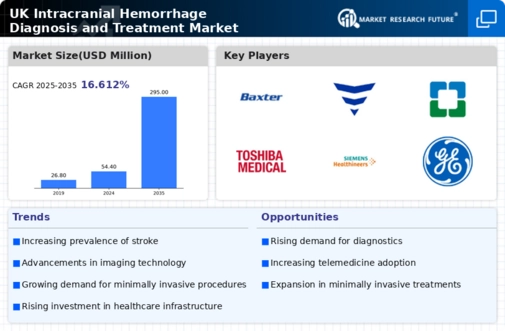Market Growth Projections
The Global UK Intracranial Hemorrhage Diagnosis and Treatment Market Industry is projected to experience substantial growth over the coming years. With a market size anticipated to reach 1250 USD Million in 2024 and further expanding to 2750 USD Million by 2035, this growth reflects the increasing demand for advanced diagnostic and treatment options. The compound annual growth rate of 7.43% from 2025 to 2035 underscores the industry's potential, driven by factors such as technological advancements, rising incidence rates, and increased healthcare expenditure. This upward trajectory indicates a robust market landscape for stakeholders.
Growing Awareness and Education
There is a growing awareness regarding the symptoms and risks associated with intracranial hemorrhage, which is positively impacting the Global UK Intracranial Hemorrhage Diagnosis and Treatment Market Industry. Public health campaigns and educational initiatives are informing the population about the importance of early diagnosis and treatment. This increased awareness is likely to lead to more individuals seeking medical attention promptly, thereby improving outcomes and reducing mortality rates. As awareness continues to rise, the market is expected to expand, driven by the demand for effective diagnostic tools and treatment options.
Increased Healthcare Expenditure
The Global UK Intracranial Hemorrhage Diagnosis and Treatment Market Industry benefits from rising healthcare expenditure, which is crucial for the development and accessibility of advanced medical treatments. Governments and private sectors are investing significantly in healthcare infrastructure, leading to improved facilities and services for patients suffering from intracranial hemorrhages. This trend is expected to support the market's growth trajectory, with a compound annual growth rate of 7.43% projected from 2025 to 2035. Enhanced funding allows for better training of healthcare professionals and the procurement of state-of-the-art medical equipment, ultimately improving patient care.
Regulatory Support and Guidelines
The Global UK Intracranial Hemorrhage Diagnosis and Treatment Market Industry is supported by regulatory bodies that establish guidelines for the diagnosis and management of intracranial hemorrhages. These guidelines promote best practices and encourage the adoption of standardized treatment protocols, which can enhance patient safety and treatment efficacy. Regulatory support also facilitates the approval of new medical devices and therapies, fostering innovation within the market. As regulations evolve to accommodate advancements in medical technology, the industry is likely to experience sustained growth, aligning with the increasing demand for effective treatment solutions.
Advancements in Diagnostic Technologies
Technological innovations in diagnostic imaging are significantly influencing the Global UK Intracranial Hemorrhage Diagnosis and Treatment Market Industry. Enhanced imaging techniques, such as CT and MRI scans, allow for quicker and more accurate diagnosis of intracranial hemorrhages. These advancements not only improve patient outcomes but also streamline treatment protocols, thereby increasing the efficiency of healthcare systems. As diagnostic technologies evolve, the market is projected to grow, reaching an estimated 2750 USD Million by 2035. The integration of artificial intelligence in imaging analysis further enhances diagnostic accuracy, indicating a promising future for the industry.
Rising Incidence of Intracranial Hemorrhage
The Global UK Intracranial Hemorrhage Diagnosis and Treatment Market Industry is witnessing a notable increase in the incidence of intracranial hemorrhage, driven by factors such as an aging population and the prevalence of risk factors like hypertension and anticoagulant therapy. As the population ages, the number of individuals susceptible to conditions leading to hemorrhagic strokes rises. This trend is expected to contribute to the market's growth, with projections indicating a market size of 1250 USD Million in 2024. The increasing demand for effective diagnostic and treatment options is likely to propel advancements in medical technology and healthcare services.



















Leave a Comment